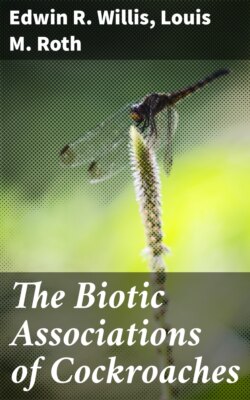Читать книгу The Biotic Associations of Cockroaches - Edwin R. Willis - Страница 296
На сайте Литреса книга снята с продажи.
Parcoblatta fulvescens
ОглавлениеEastern and southeastern U.S.—Trapped in molasses jars: in heavy, barrier-beach forest; in typical pine-barrens undergrowth; in pine barrens with heavy, grassy undergrowth; on border of pine barrens and on edge of swamp; in heavy deciduous forest; in heavy oak woods. Found under debris in dead, shortleaf-pine needles; under dead leaves on edge of oak and shortleaf-pine woods; under bark of pine log; among dead leaves under live oaks; under sign on Pinus caribaea (Hebard, 1917).
Georgia.—From under bark of pine log, among dead leaves under live oaks, and under leaves on edge of oak and shortleaf-pine woods (Rehn and Hebard, 1916).
Florida.—Very common among dead leaves, under logs, beneath loose bark, and wanders about at night in pinelands, hammock, turkey oak, and sand-scrub habitats (Hubbell and Goff, 1940). Beneath drift, cow dung, leaves, boards, bark of logs, and other debris, usually in open pine woods in sandy areas; frequent at the base of thistle leaves (Blatchley, 1920). Friauf (1953) found this species in leaf duff, debris, or decaying wood in these habitats: Scrub (dominant), sandhills (dominant), xeric hammock (dominant), mesic hammock, longleaf-pine flatwoods (infrequent), low hammock (infrequent), and alluvial hammock (infrequent). In the shrub stratum in these habitats: Scrub (dominant), sandhills (dominant), xeric hammock (dominant), and longleaf-pine flatwoods (infrequent). In the herbaceous stratum of the longleaf-pine flatwoods habitat, and under bark and beneath logs in the woodpile habitat.
